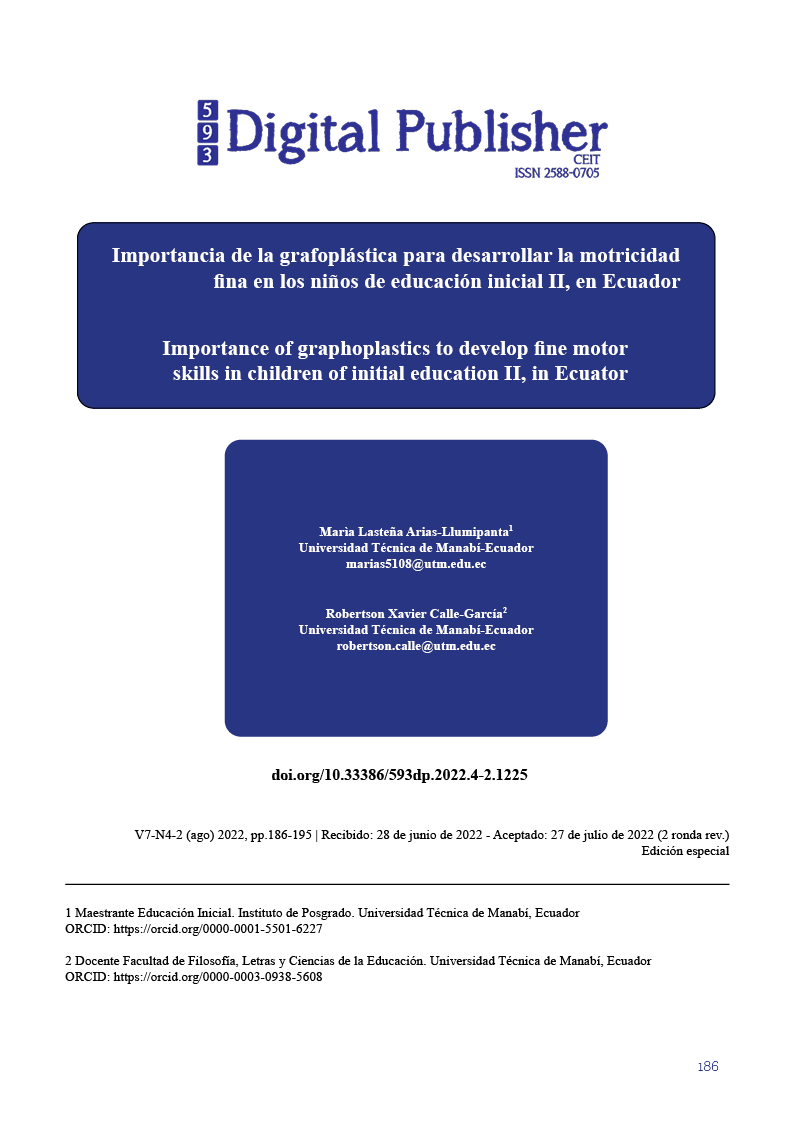Importance of graphoplastics to develop fine motor skills in children of initial education II, in Ecuator
Main Article Content
Abstract
Teachers in their daily work must use different strategies to work on the psychomotor development of children, turning plastic graph techniques into an important link in the stimulation that the student needs to strengthen the muscles and joints of the hands and fingers before initiate graphomotor activities. Thus, the objective of this research is to propose a set of plastic graph techniques for the development of fine motor skills in children of Initial Education II. A descriptive scope methodology was used, with a qualitative approach, and a non-experimental design. The instruments used were multiple choice surveys for the four initial education teachers and observation sheets to evaluate the children. The results obtained showed that when applying graphoplastic techniques, in 65.6 children improved fine motor skills. It is concluded that it is important to apply graphoplastic techniques because they help with the development of fine motor skills, the same that is necessary to achieve postural control, manual eye dexterity, pencil handling control, actions that allow children to easily function in various activities, strengthening their abilities and skills.
Downloads
Article Details

This work is licensed under a Creative Commons Attribution-NonCommercial-ShareAlike 4.0 International License.
1. Derechos de autor
Las obras que se publican en 593 Digital Publisher CEIT están sujetas a los siguientes términos:
1.1. 593 Digital Publisher CEIT, conserva los derechos patrimoniales (copyright) de las obras publicadas, favorece y permite la reutilización de las mismas bajo la licencia Licencia Creative Commons 4.0 de Reconocimiento-NoComercial-CompartirIgual 4.0, por lo cual se pueden copiar, usar, difundir, transmitir y exponer públicamente, siempre que:
1.1.a. Se cite la autoría y fuente original de su publicación (revista, editorial, URL).
1.1.b. No se usen para fines comerciales u onerosos.
1.1.c. Se mencione la existencia y especificaciones de esta licencia de uso.
References
Arias, J., Villasís, M., & Novales, M. (2016). El protocolo de investigación III: la población de estudio. Revista Alergia México, 63(2), 201-206. https://www.redalyc.org/pdf/4867/486755023011.pdf
Cabrera, B. & Dupeyrón, M. (2019). El desarrollo y la estimulación de la motricidad fina en los niños y niñas del grado preescolar. Mendive, 17(2), 222-239. https://dialnet.unirioja.es/servlet/articulo?codigo=7050503
Cándales, R. (2012) La capacitación psicopedagógica para desarrollar la motricidad fina en los niños de 3 a 6 años del Centro de Educación Nacional Bolivariano “El Llano”. 12(39), 61-71. https://www.redalyc.org/articulo.oa?id=475748678008
Copo, J., y Llamuca, A. (2020). Aplicación de técnicas grafo plásticas para el desarrollo de la pinza digital de los niños y niñas de 3 a 4 años de la unidad educativa Pedro Fermín Cevallos. Revista científico - educacional de la provincia Granma, 16, 404-414. https://dialnet.unirioja.es/servlet/articulo?codigo=7414339
Díaz, T., Bumbila, B., & Bravo, G. (2017). Las técnicas grafo plásticos y la pre escritura. Revista Atlante: Cuadernos de Educación y Desarrollo. Revista Atlante: Cuadernos de Educación y Desarrollo. https://www.eumed.net/rev/atlante/2017/06/pre-escritura.html
Fernández, E. García, D., Álvarez, M., Erazo, J. (2020) Desarrollo de técnicas grafo-plásticas con recursos educativos no estructurados. Revista Arbitrada Interdisciplinaria Koinonía, Vol. 5, https://dialnet.unirioja.es/servlet/articulo?codigo=7610730
García, M., & Batista, L. (2018). El desarrollo de la motricidad fina en los niños y las niñas de la primera infancia. Atlante Cuadernos de Educación y Desarrollo, 8. https://www.eumed.net/rev/atlante/2018/08/motricidad-primera-infancia.html
González, M., García, D., Erazo, C., & Erazo, J. (2020) Creatividad y técnicas grafoplástica innovadoras. Revista Arbitrada Interdisciplinaria Koinonía, Vol. 5, Nº. Extra 1, 2020. https://dialnet.unirioja.es/servlet/articulo?codigo=7610749
Henao, A., Bedoya, G., & Silva, A. (2015). La expresión gráfico-plástica en la primera infancia: una alternativa didáctica y pedagógica. Revista Fundación Universitaria Luis Amigó (histórico), 2(2), 208-223. file:///C:/Users/acer/Downloads/1673-6561-1-PB%20(5).pdf
Hernández-Sampieri y Mendoza (2008) Metodología de la Investigación, Sexta Edición. https://periodicooficial.jalisco.gob.mx/sites/periodicooficial.jalisco.gob.mx/files/metodologia_de_la_investigacion_-_roberto_hernandez_sampieri.pdf
Jiménez, L. (2012). La grafoplástica como estrategia de estimulación temprana en la estructuración del esquema corporal en niños institucionalizados. Revista de Investigación Psicológica, (8), 147-160. http://www.scielo.org.bo/pdf/rip/n8/n8a09.pdf
Ley Orgánica de Educación Intercultural del Ecuador (2011). Registro Oficial N° 417 Segundo Suplemento. https://oig.cepal.org/sites/default/files/2011_leyeducacionintercultural_ecu.pdf
Ministerio de Educación del Ecuador. Currículo de Educación Inicial 2014. https://educacion.gob.ec/wp-content/uploads/downloads/2014/06/curriculo-educacion-inicial-lowres.pdf
Ramírez, G., Gutiérrez, M., León, A., Vargas, M. (2017). Coordinación grafoperceptiva: Incidencia en el desarrollo de la motricidad fina en niños de 5 a 6 años de edad. Revista Ciencia Unemi, 10(22), 40-47. https://www.redalyc.org/articulo.oa?id=582661263004
Razeto, A. (2016). El involucramiento de las familias en la educación de los niños: Cuatro reflexiones para fortalecer la relación entre familias y escuelas. Páginas de educación. 9(2), 184-201. http://www.scielo.edu.uy/pdf/pe/v9n2/v9n2a07.pdf
UNICEF (2017) Desarrollo de la primera infancia. Un periodo crucial del desarrollo que establece las bases para el bienestar futuro, el aprendizaje y la participación de las niñas y niños. https://www.unicef.org/lac/desarrollo-de-la-primera-infancia
UNICEF (2017) Orientación Programática de Unicef para el desarrollo de los niños y las niñas en la primera infancia. https://www.unicef.org/sites/default/files/2018-12/Programme%20Guidance%20for%20ECD%20%28SPANISH%29_1.pdf
Vintimilla, M., Garcia., D, Álvarez, M. & Erazo, J. (2020) Estrategias Pedagógicas para el desarrollo de la grafomotricidad. Revista Arbitrada Interdisciplinaria KOINONIA. Vol. V. N°1. https://dialnet.unirioja.es/servlet/articulo?codigo=7610732
Zamora, C., Romero, C., Pérez, M., & Paula, M. (2020). Medio de enseñanza para el desarrollo de habilidades motrices básicas en niños de sexto año de vida. Revista de Ciencia y Tecnología en la Cultura Física, 15(2), 221-237. http://scielo.sld.cu/pdf/rpp/v15n2/1996-2452-rpp-15-02-221.pdf



